Sustainable Energy Report: CSP Technology in India
VerifiedAdded on 2021/06/15
|22
|5917
|255
Report
AI Summary
This report provides an in-depth analysis of Concentrating Solar Power (CSP) technology in India, examining its current state, technological advancements, and potential impact on the country's energy systems. It explores the different types of CSP technologies, including parabolic trough, power tower, and dish Stirling systems, detailing their working mechanisms, advantages, and disadvantages. The report highlights India's commitment to sustainable energy goals, the potential of CSP given its geographical and climatic characteristics, and the progress made in implementing CSP plants. It also discusses the barriers and opportunities associated with CSP energy in India, including economic, technological, and environmental considerations, providing a comprehensive overview of the challenges and prospects for CSP's role in India's energy future.
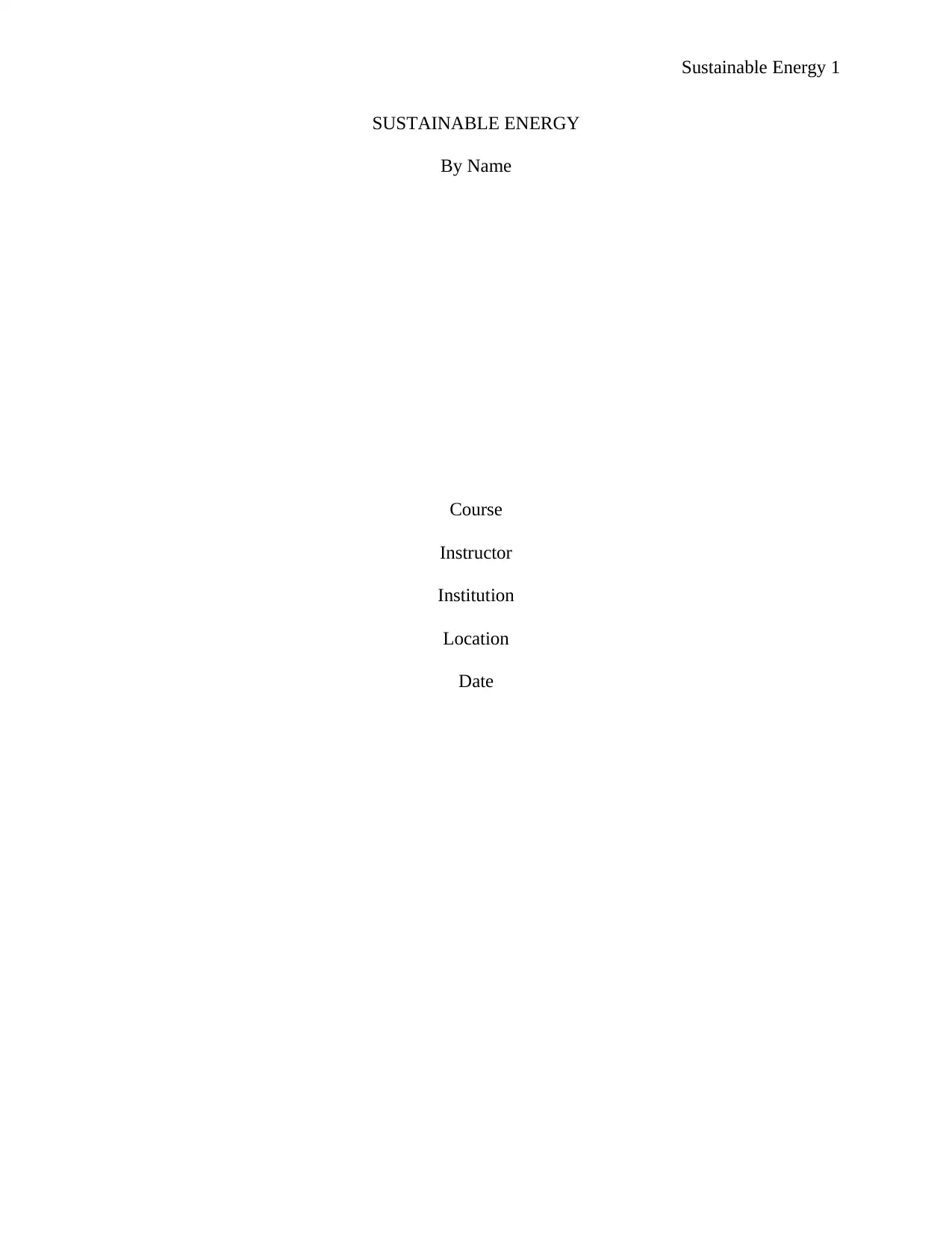
Sustainable Energy 1
SUSTAINABLE ENERGY
By Name
Course
Instructor
Institution
Location
Date
SUSTAINABLE ENERGY
By Name
Course
Instructor
Institution
Location
Date
Paraphrase This Document
Need a fresh take? Get an instant paraphrase of this document with our AI Paraphraser
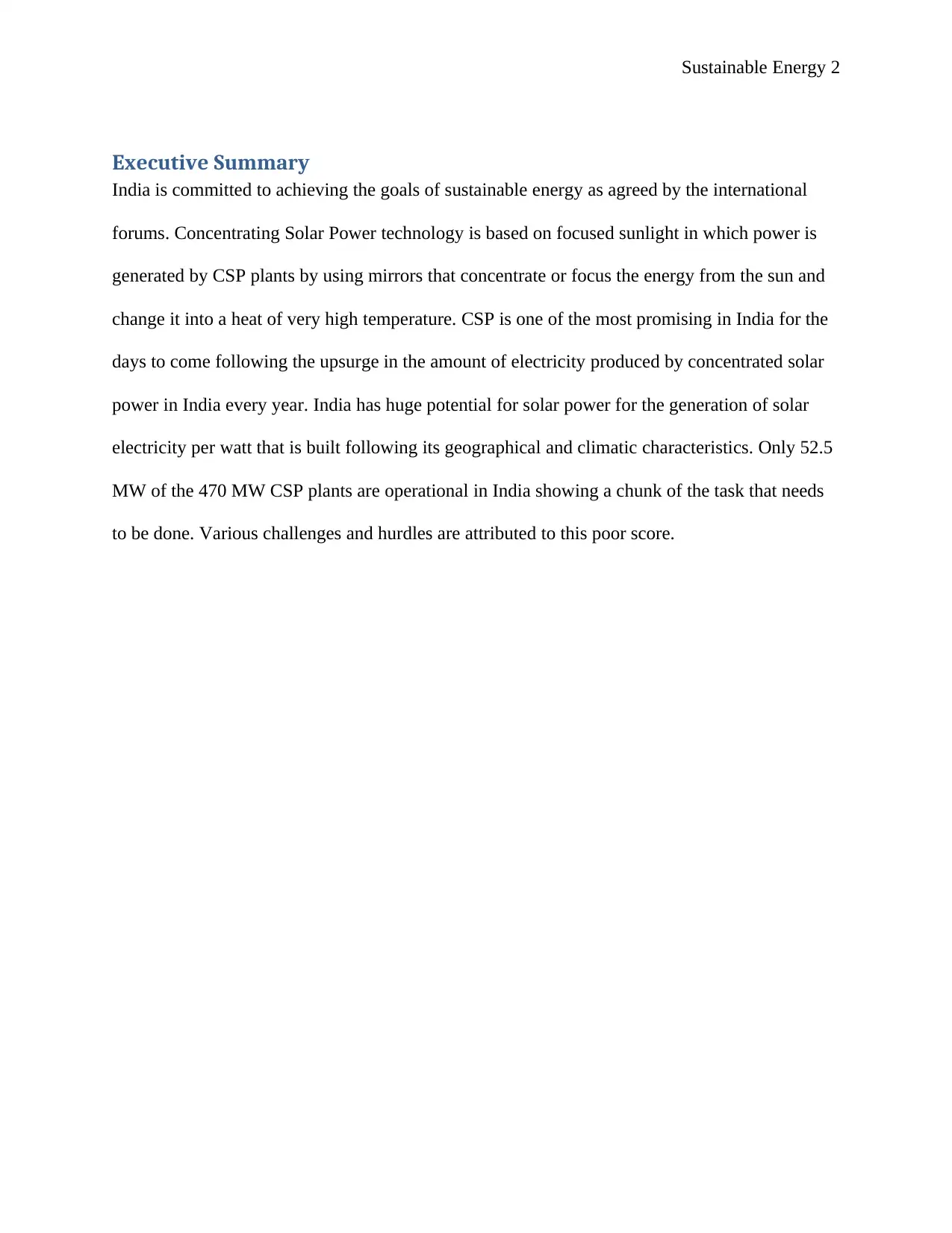
Sustainable Energy 2
Executive Summary
India is committed to achieving the goals of sustainable energy as agreed by the international
forums. Concentrating Solar Power technology is based on focused sunlight in which power is
generated by CSP plants by using mirrors that concentrate or focus the energy from the sun and
change it into a heat of very high temperature. CSP is one of the most promising in India for the
days to come following the upsurge in the amount of electricity produced by concentrated solar
power in India every year. India has huge potential for solar power for the generation of solar
electricity per watt that is built following its geographical and climatic characteristics. Only 52.5
MW of the 470 MW CSP plants are operational in India showing a chunk of the task that needs
to be done. Various challenges and hurdles are attributed to this poor score.
Executive Summary
India is committed to achieving the goals of sustainable energy as agreed by the international
forums. Concentrating Solar Power technology is based on focused sunlight in which power is
generated by CSP plants by using mirrors that concentrate or focus the energy from the sun and
change it into a heat of very high temperature. CSP is one of the most promising in India for the
days to come following the upsurge in the amount of electricity produced by concentrated solar
power in India every year. India has huge potential for solar power for the generation of solar
electricity per watt that is built following its geographical and climatic characteristics. Only 52.5
MW of the 470 MW CSP plants are operational in India showing a chunk of the task that needs
to be done. Various challenges and hurdles are attributed to this poor score.
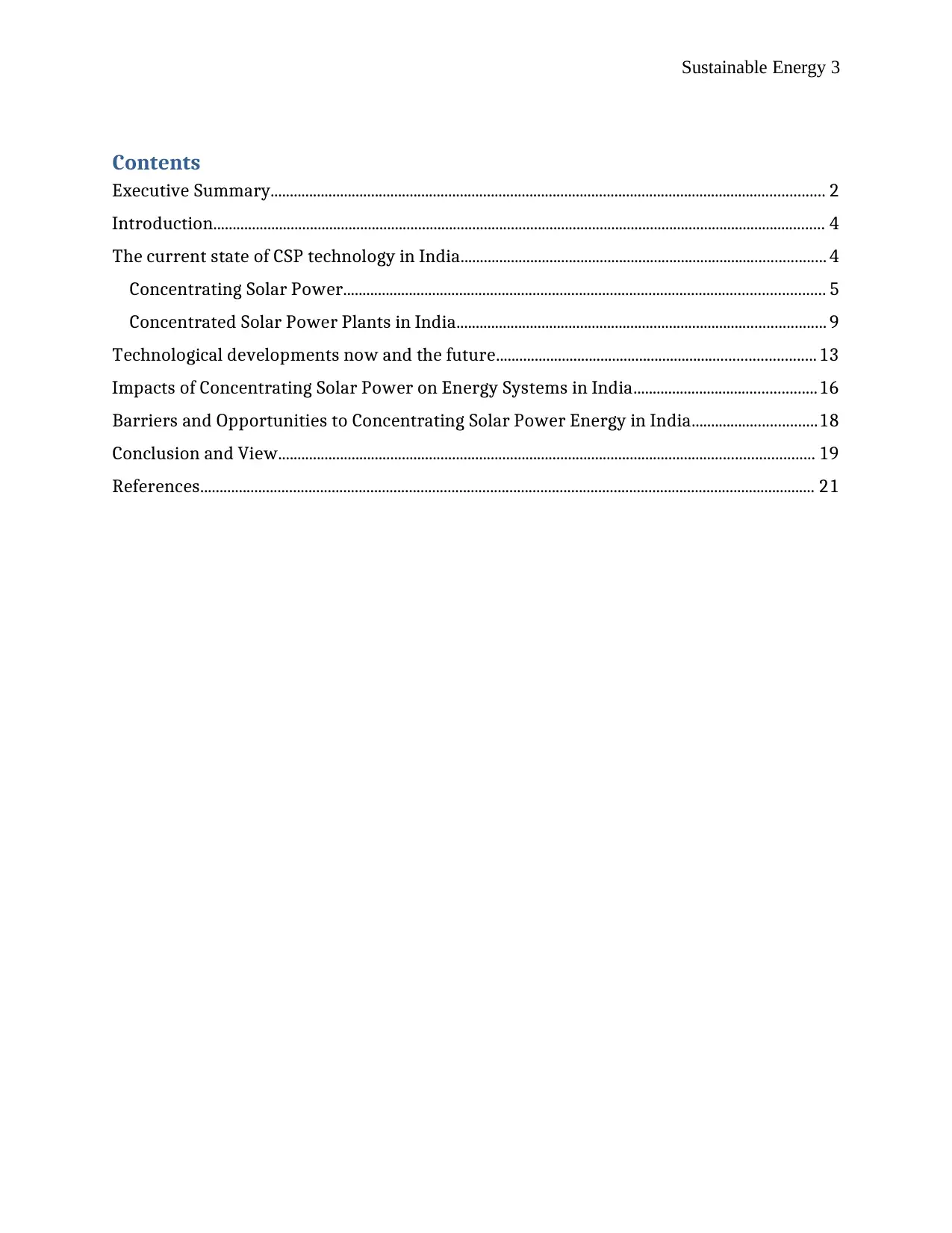
Sustainable Energy 3
Contents
Executive Summary............................................................................................................................................... 2
Introduction.............................................................................................................................................................. 4
The current state of CSP technology in India.............................................................................................. 4
Concentrating Solar Power............................................................................................................................ 5
Concentrated Solar Power Plants in India............................................................................................... 9
Technological developments now and the future..................................................................................13
Impacts of Concentrating Solar Power on Energy Systems in India...............................................16
Barriers and Opportunities to Concentrating Solar Power Energy in India................................18
Conclusion and View.......................................................................................................................................... 19
References............................................................................................................................................................... 21
Contents
Executive Summary............................................................................................................................................... 2
Introduction.............................................................................................................................................................. 4
The current state of CSP technology in India.............................................................................................. 4
Concentrating Solar Power............................................................................................................................ 5
Concentrated Solar Power Plants in India............................................................................................... 9
Technological developments now and the future..................................................................................13
Impacts of Concentrating Solar Power on Energy Systems in India...............................................16
Barriers and Opportunities to Concentrating Solar Power Energy in India................................18
Conclusion and View.......................................................................................................................................... 19
References............................................................................................................................................................... 21
⊘ This is a preview!⊘
Do you want full access?
Subscribe today to unlock all pages.

Trusted by 1+ million students worldwide
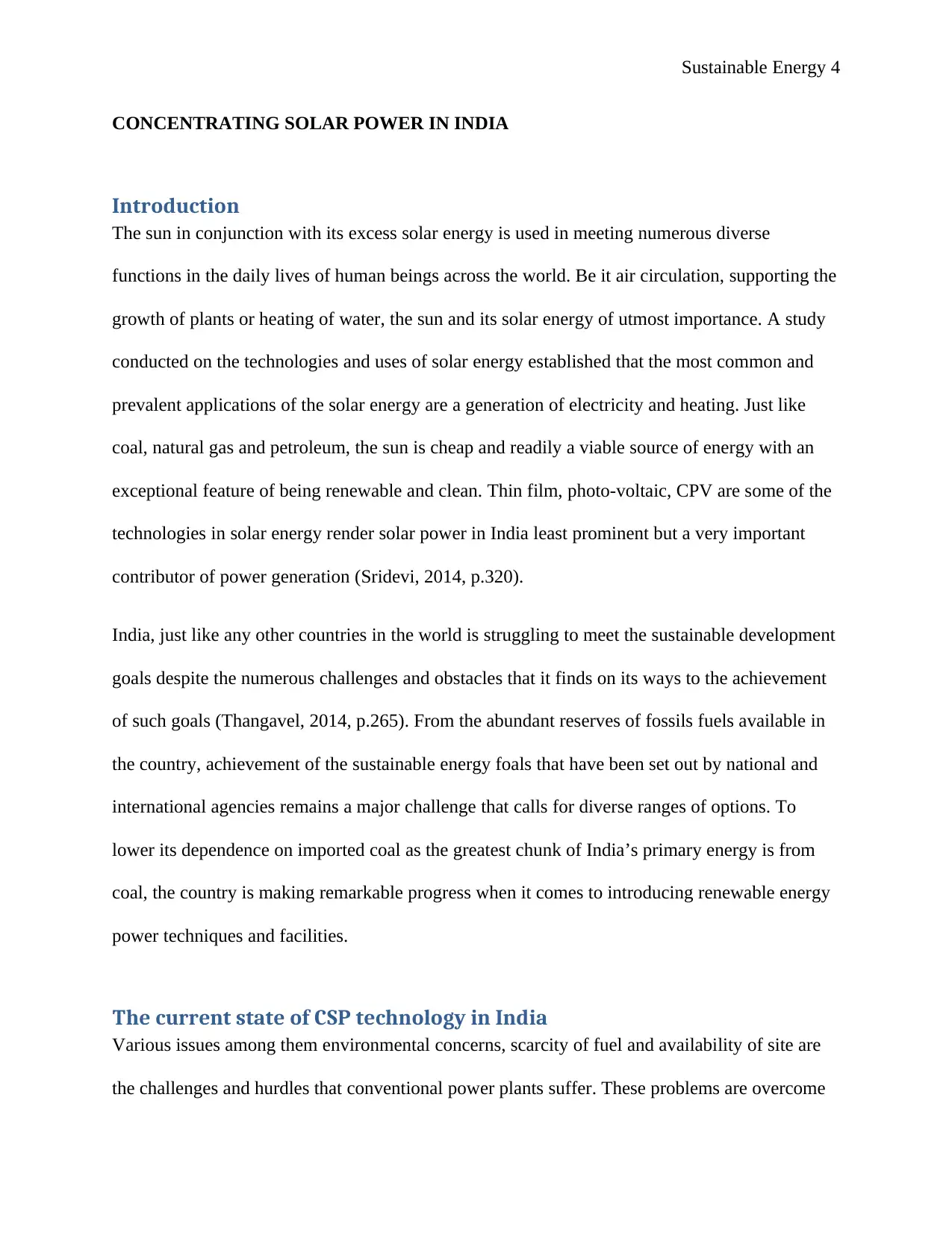
Sustainable Energy 4
CONCENTRATING SOLAR POWER IN INDIA
Introduction
The sun in conjunction with its excess solar energy is used in meeting numerous diverse
functions in the daily lives of human beings across the world. Be it air circulation, supporting the
growth of plants or heating of water, the sun and its solar energy of utmost importance. A study
conducted on the technologies and uses of solar energy established that the most common and
prevalent applications of the solar energy are a generation of electricity and heating. Just like
coal, natural gas and petroleum, the sun is cheap and readily a viable source of energy with an
exceptional feature of being renewable and clean. Thin film, photo-voltaic, CPV are some of the
technologies in solar energy render solar power in India least prominent but a very important
contributor of power generation (Sridevi, 2014, p.320).
India, just like any other countries in the world is struggling to meet the sustainable development
goals despite the numerous challenges and obstacles that it finds on its ways to the achievement
of such goals (Thangavel, 2014, p.265). From the abundant reserves of fossils fuels available in
the country, achievement of the sustainable energy foals that have been set out by national and
international agencies remains a major challenge that calls for diverse ranges of options. To
lower its dependence on imported coal as the greatest chunk of India’s primary energy is from
coal, the country is making remarkable progress when it comes to introducing renewable energy
power techniques and facilities.
The current state of CSP technology in India
Various issues among them environmental concerns, scarcity of fuel and availability of site are
the challenges and hurdles that conventional power plants suffer. These problems are overcome
CONCENTRATING SOLAR POWER IN INDIA
Introduction
The sun in conjunction with its excess solar energy is used in meeting numerous diverse
functions in the daily lives of human beings across the world. Be it air circulation, supporting the
growth of plants or heating of water, the sun and its solar energy of utmost importance. A study
conducted on the technologies and uses of solar energy established that the most common and
prevalent applications of the solar energy are a generation of electricity and heating. Just like
coal, natural gas and petroleum, the sun is cheap and readily a viable source of energy with an
exceptional feature of being renewable and clean. Thin film, photo-voltaic, CPV are some of the
technologies in solar energy render solar power in India least prominent but a very important
contributor of power generation (Sridevi, 2014, p.320).
India, just like any other countries in the world is struggling to meet the sustainable development
goals despite the numerous challenges and obstacles that it finds on its ways to the achievement
of such goals (Thangavel, 2014, p.265). From the abundant reserves of fossils fuels available in
the country, achievement of the sustainable energy foals that have been set out by national and
international agencies remains a major challenge that calls for diverse ranges of options. To
lower its dependence on imported coal as the greatest chunk of India’s primary energy is from
coal, the country is making remarkable progress when it comes to introducing renewable energy
power techniques and facilities.
The current state of CSP technology in India
Various issues among them environmental concerns, scarcity of fuel and availability of site are
the challenges and hurdles that conventional power plants suffer. These problems are overcome
Paraphrase This Document
Need a fresh take? Get an instant paraphrase of this document with our AI Paraphraser
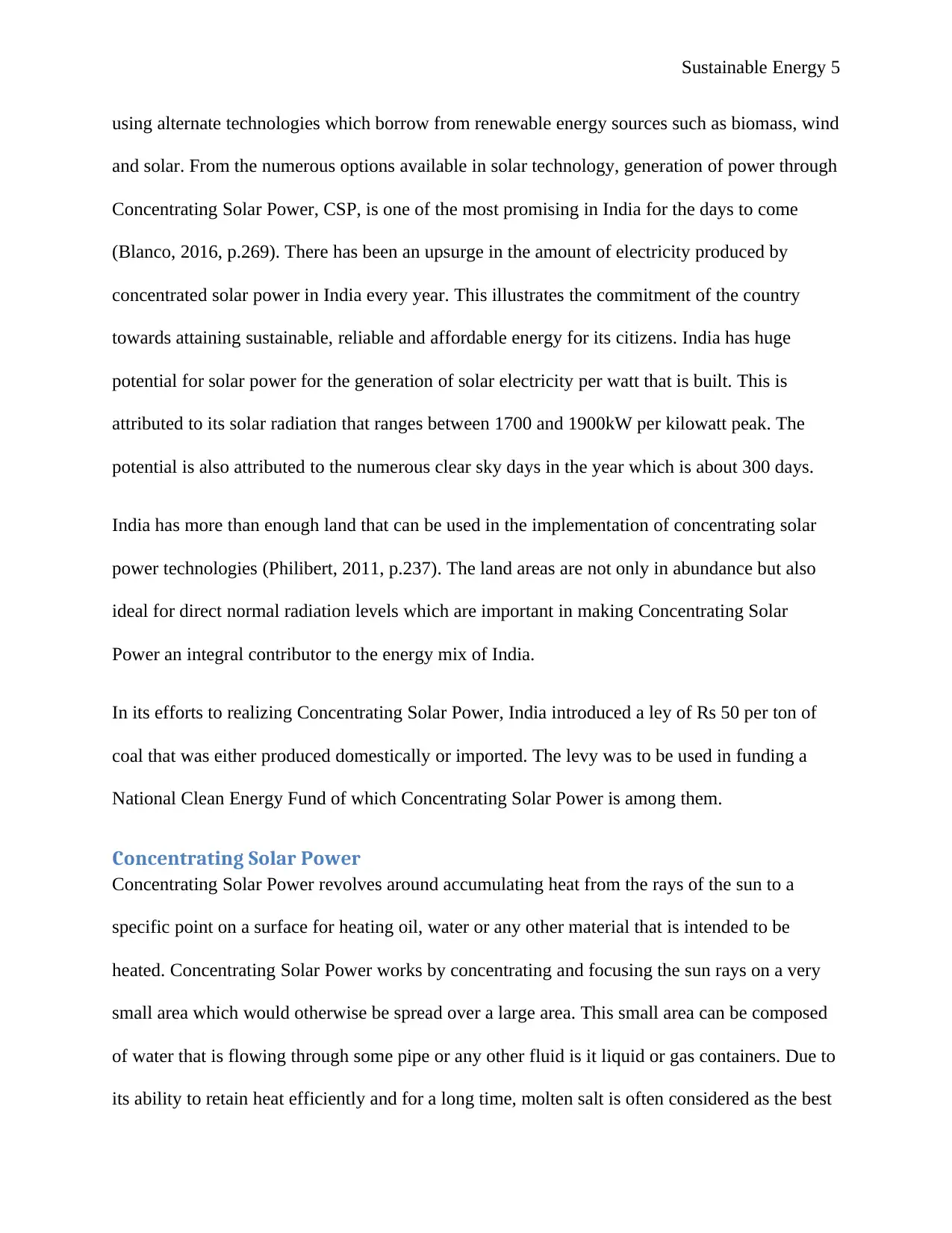
Sustainable Energy 5
using alternate technologies which borrow from renewable energy sources such as biomass, wind
and solar. From the numerous options available in solar technology, generation of power through
Concentrating Solar Power, CSP, is one of the most promising in India for the days to come
(Blanco, 2016, p.269). There has been an upsurge in the amount of electricity produced by
concentrated solar power in India every year. This illustrates the commitment of the country
towards attaining sustainable, reliable and affordable energy for its citizens. India has huge
potential for solar power for the generation of solar electricity per watt that is built. This is
attributed to its solar radiation that ranges between 1700 and 1900kW per kilowatt peak. The
potential is also attributed to the numerous clear sky days in the year which is about 300 days.
India has more than enough land that can be used in the implementation of concentrating solar
power technologies (Philibert, 2011, p.237). The land areas are not only in abundance but also
ideal for direct normal radiation levels which are important in making Concentrating Solar
Power an integral contributor to the energy mix of India.
In its efforts to realizing Concentrating Solar Power, India introduced a ley of Rs 50 per ton of
coal that was either produced domestically or imported. The levy was to be used in funding a
National Clean Energy Fund of which Concentrating Solar Power is among them.
Concentrating Solar Power
Concentrating Solar Power revolves around accumulating heat from the rays of the sun to a
specific point on a surface for heating oil, water or any other material that is intended to be
heated. Concentrating Solar Power works by concentrating and focusing the sun rays on a very
small area which would otherwise be spread over a large area. This small area can be composed
of water that is flowing through some pipe or any other fluid is it liquid or gas containers. Due to
its ability to retain heat efficiently and for a long time, molten salt is often considered as the best
using alternate technologies which borrow from renewable energy sources such as biomass, wind
and solar. From the numerous options available in solar technology, generation of power through
Concentrating Solar Power, CSP, is one of the most promising in India for the days to come
(Blanco, 2016, p.269). There has been an upsurge in the amount of electricity produced by
concentrated solar power in India every year. This illustrates the commitment of the country
towards attaining sustainable, reliable and affordable energy for its citizens. India has huge
potential for solar power for the generation of solar electricity per watt that is built. This is
attributed to its solar radiation that ranges between 1700 and 1900kW per kilowatt peak. The
potential is also attributed to the numerous clear sky days in the year which is about 300 days.
India has more than enough land that can be used in the implementation of concentrating solar
power technologies (Philibert, 2011, p.237). The land areas are not only in abundance but also
ideal for direct normal radiation levels which are important in making Concentrating Solar
Power an integral contributor to the energy mix of India.
In its efforts to realizing Concentrating Solar Power, India introduced a ley of Rs 50 per ton of
coal that was either produced domestically or imported. The levy was to be used in funding a
National Clean Energy Fund of which Concentrating Solar Power is among them.
Concentrating Solar Power
Concentrating Solar Power revolves around accumulating heat from the rays of the sun to a
specific point on a surface for heating oil, water or any other material that is intended to be
heated. Concentrating Solar Power works by concentrating and focusing the sun rays on a very
small area which would otherwise be spread over a large area. This small area can be composed
of water that is flowing through some pipe or any other fluid is it liquid or gas containers. Due to
its ability to retain heat efficiently and for a long time, molten salt is often considered as the best
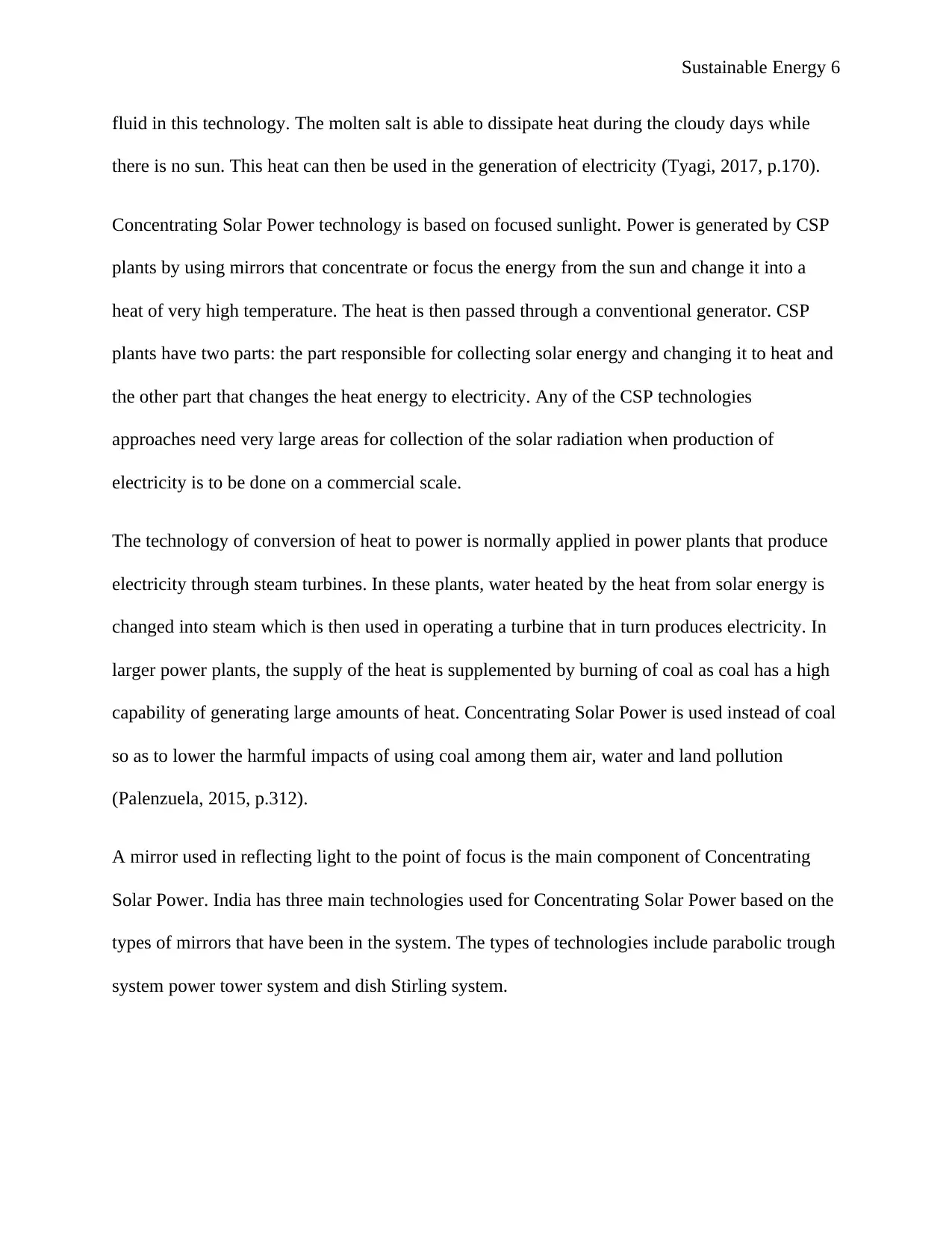
Sustainable Energy 6
fluid in this technology. The molten salt is able to dissipate heat during the cloudy days while
there is no sun. This heat can then be used in the generation of electricity (Tyagi, 2017, p.170).
Concentrating Solar Power technology is based on focused sunlight. Power is generated by CSP
plants by using mirrors that concentrate or focus the energy from the sun and change it into a
heat of very high temperature. The heat is then passed through a conventional generator. CSP
plants have two parts: the part responsible for collecting solar energy and changing it to heat and
the other part that changes the heat energy to electricity. Any of the CSP technologies
approaches need very large areas for collection of the solar radiation when production of
electricity is to be done on a commercial scale.
The technology of conversion of heat to power is normally applied in power plants that produce
electricity through steam turbines. In these plants, water heated by the heat from solar energy is
changed into steam which is then used in operating a turbine that in turn produces electricity. In
larger power plants, the supply of the heat is supplemented by burning of coal as coal has a high
capability of generating large amounts of heat. Concentrating Solar Power is used instead of coal
so as to lower the harmful impacts of using coal among them air, water and land pollution
(Palenzuela, 2015, p.312).
A mirror used in reflecting light to the point of focus is the main component of Concentrating
Solar Power. India has three main technologies used for Concentrating Solar Power based on the
types of mirrors that have been in the system. The types of technologies include parabolic trough
system power tower system and dish Stirling system.
fluid in this technology. The molten salt is able to dissipate heat during the cloudy days while
there is no sun. This heat can then be used in the generation of electricity (Tyagi, 2017, p.170).
Concentrating Solar Power technology is based on focused sunlight. Power is generated by CSP
plants by using mirrors that concentrate or focus the energy from the sun and change it into a
heat of very high temperature. The heat is then passed through a conventional generator. CSP
plants have two parts: the part responsible for collecting solar energy and changing it to heat and
the other part that changes the heat energy to electricity. Any of the CSP technologies
approaches need very large areas for collection of the solar radiation when production of
electricity is to be done on a commercial scale.
The technology of conversion of heat to power is normally applied in power plants that produce
electricity through steam turbines. In these plants, water heated by the heat from solar energy is
changed into steam which is then used in operating a turbine that in turn produces electricity. In
larger power plants, the supply of the heat is supplemented by burning of coal as coal has a high
capability of generating large amounts of heat. Concentrating Solar Power is used instead of coal
so as to lower the harmful impacts of using coal among them air, water and land pollution
(Palenzuela, 2015, p.312).
A mirror used in reflecting light to the point of focus is the main component of Concentrating
Solar Power. India has three main technologies used for Concentrating Solar Power based on the
types of mirrors that have been in the system. The types of technologies include parabolic trough
system power tower system and dish Stirling system.
⊘ This is a preview!⊘
Do you want full access?
Subscribe today to unlock all pages.

Trusted by 1+ million students worldwide
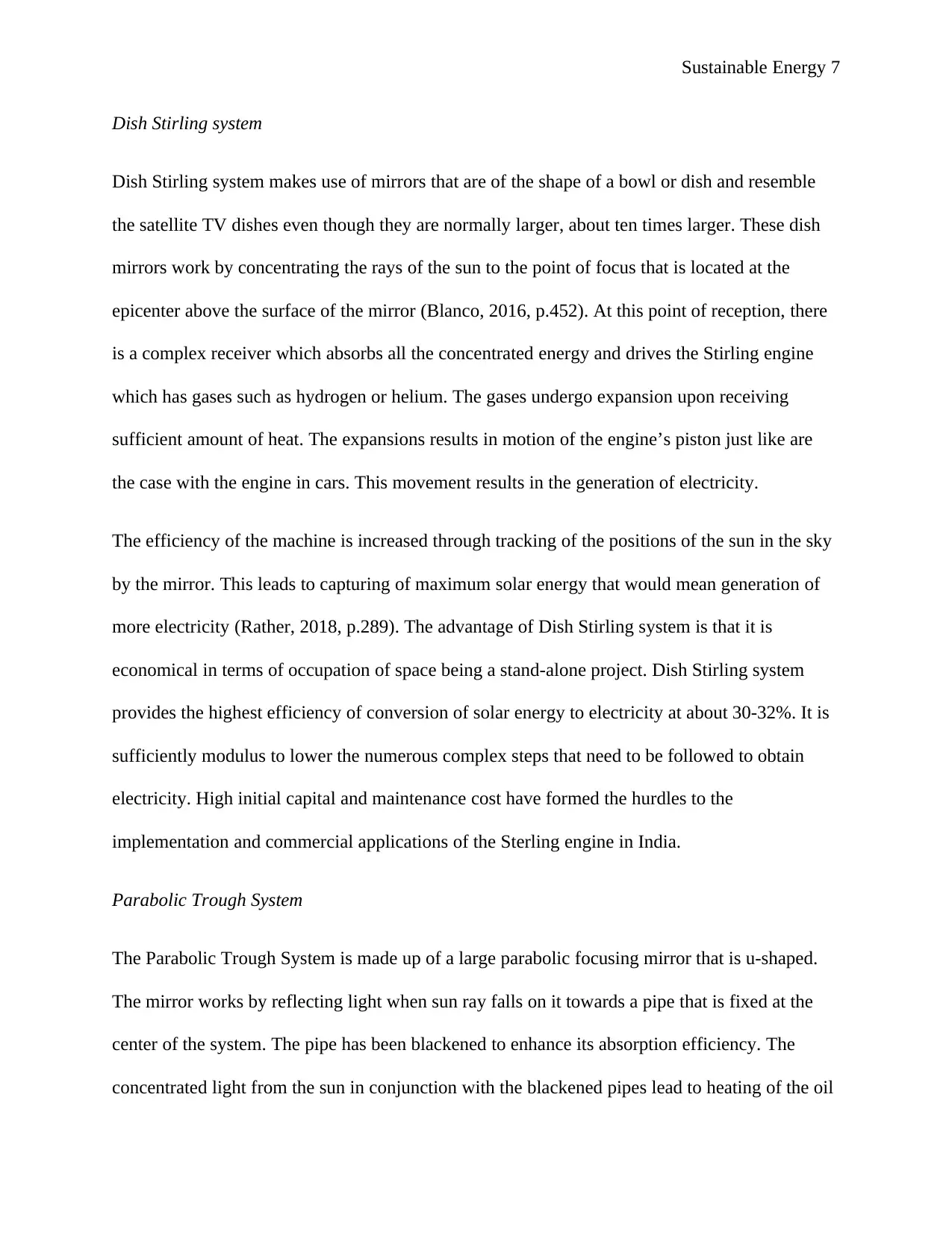
Sustainable Energy 7
Dish Stirling system
Dish Stirling system makes use of mirrors that are of the shape of a bowl or dish and resemble
the satellite TV dishes even though they are normally larger, about ten times larger. These dish
mirrors work by concentrating the rays of the sun to the point of focus that is located at the
epicenter above the surface of the mirror (Blanco, 2016, p.452). At this point of reception, there
is a complex receiver which absorbs all the concentrated energy and drives the Stirling engine
which has gases such as hydrogen or helium. The gases undergo expansion upon receiving
sufficient amount of heat. The expansions results in motion of the engine’s piston just like are
the case with the engine in cars. This movement results in the generation of electricity.
The efficiency of the machine is increased through tracking of the positions of the sun in the sky
by the mirror. This leads to capturing of maximum solar energy that would mean generation of
more electricity (Rather, 2018, p.289). The advantage of Dish Stirling system is that it is
economical in terms of occupation of space being a stand-alone project. Dish Stirling system
provides the highest efficiency of conversion of solar energy to electricity at about 30-32%. It is
sufficiently modulus to lower the numerous complex steps that need to be followed to obtain
electricity. High initial capital and maintenance cost have formed the hurdles to the
implementation and commercial applications of the Sterling engine in India.
Parabolic Trough System
The Parabolic Trough System is made up of a large parabolic focusing mirror that is u-shaped.
The mirror works by reflecting light when sun ray falls on it towards a pipe that is fixed at the
center of the system. The pipe has been blackened to enhance its absorption efficiency. The
concentrated light from the sun in conjunction with the blackened pipes lead to heating of the oil
Dish Stirling system
Dish Stirling system makes use of mirrors that are of the shape of a bowl or dish and resemble
the satellite TV dishes even though they are normally larger, about ten times larger. These dish
mirrors work by concentrating the rays of the sun to the point of focus that is located at the
epicenter above the surface of the mirror (Blanco, 2016, p.452). At this point of reception, there
is a complex receiver which absorbs all the concentrated energy and drives the Stirling engine
which has gases such as hydrogen or helium. The gases undergo expansion upon receiving
sufficient amount of heat. The expansions results in motion of the engine’s piston just like are
the case with the engine in cars. This movement results in the generation of electricity.
The efficiency of the machine is increased through tracking of the positions of the sun in the sky
by the mirror. This leads to capturing of maximum solar energy that would mean generation of
more electricity (Rather, 2018, p.289). The advantage of Dish Stirling system is that it is
economical in terms of occupation of space being a stand-alone project. Dish Stirling system
provides the highest efficiency of conversion of solar energy to electricity at about 30-32%. It is
sufficiently modulus to lower the numerous complex steps that need to be followed to obtain
electricity. High initial capital and maintenance cost have formed the hurdles to the
implementation and commercial applications of the Sterling engine in India.
Parabolic Trough System
The Parabolic Trough System is made up of a large parabolic focusing mirror that is u-shaped.
The mirror works by reflecting light when sun ray falls on it towards a pipe that is fixed at the
center of the system. The pipe has been blackened to enhance its absorption efficiency. The
concentrated light from the sun in conjunction with the blackened pipes lead to heating of the oil
Paraphrase This Document
Need a fresh take? Get an instant paraphrase of this document with our AI Paraphraser
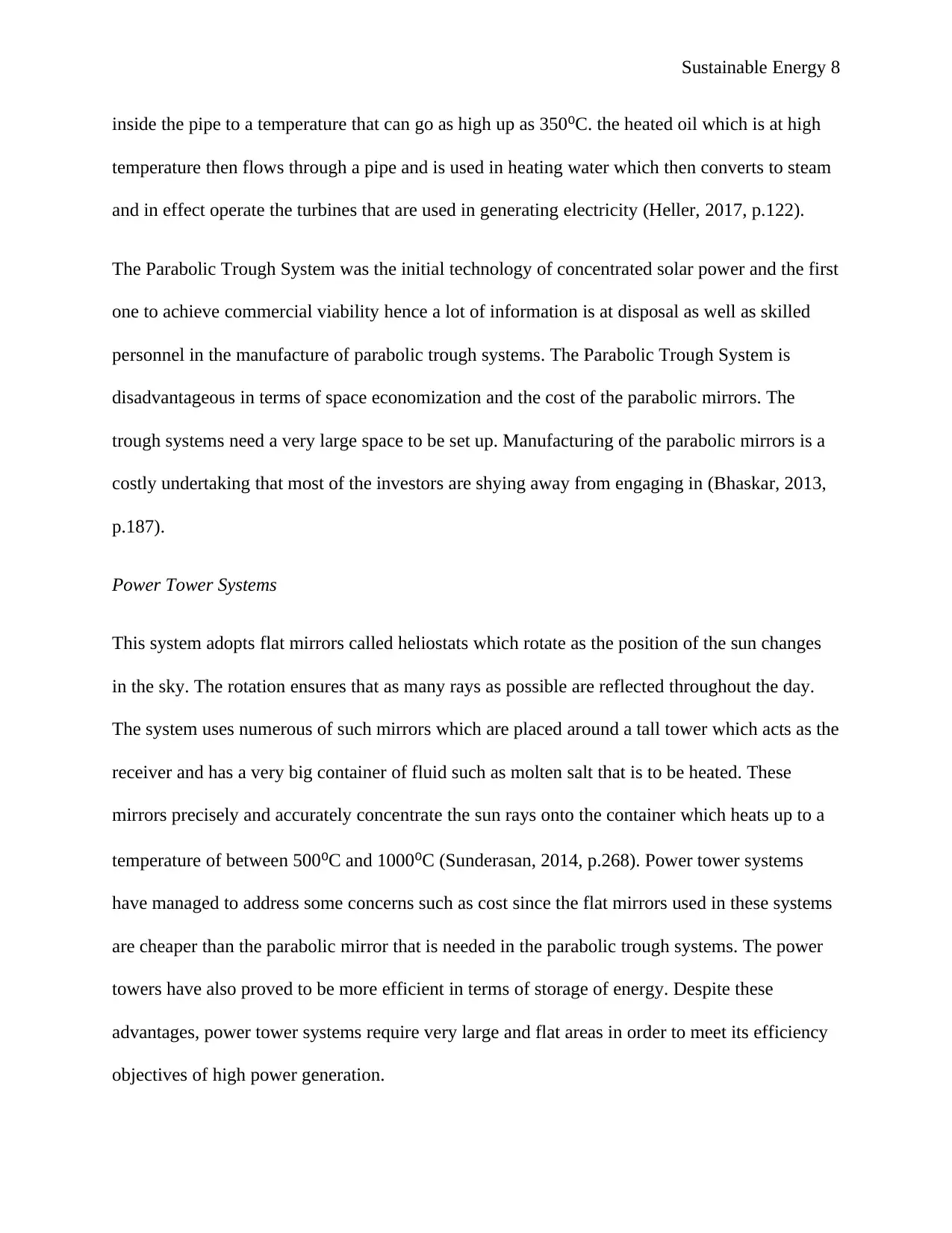
Sustainable Energy 8
inside the pipe to a temperature that can go as high up as 350⁰C. the heated oil which is at high
temperature then flows through a pipe and is used in heating water which then converts to steam
and in effect operate the turbines that are used in generating electricity (Heller, 2017, p.122).
The Parabolic Trough System was the initial technology of concentrated solar power and the first
one to achieve commercial viability hence a lot of information is at disposal as well as skilled
personnel in the manufacture of parabolic trough systems. The Parabolic Trough System is
disadvantageous in terms of space economization and the cost of the parabolic mirrors. The
trough systems need a very large space to be set up. Manufacturing of the parabolic mirrors is a
costly undertaking that most of the investors are shying away from engaging in (Bhaskar, 2013,
p.187).
Power Tower Systems
This system adopts flat mirrors called heliostats which rotate as the position of the sun changes
in the sky. The rotation ensures that as many rays as possible are reflected throughout the day.
The system uses numerous of such mirrors which are placed around a tall tower which acts as the
receiver and has a very big container of fluid such as molten salt that is to be heated. These
mirrors precisely and accurately concentrate the sun rays onto the container which heats up to a
temperature of between 500⁰C and 1000⁰C (Sunderasan, 2014, p.268). Power tower systems
have managed to address some concerns such as cost since the flat mirrors used in these systems
are cheaper than the parabolic mirror that is needed in the parabolic trough systems. The power
towers have also proved to be more efficient in terms of storage of energy. Despite these
advantages, power tower systems require very large and flat areas in order to meet its efficiency
objectives of high power generation.
inside the pipe to a temperature that can go as high up as 350⁰C. the heated oil which is at high
temperature then flows through a pipe and is used in heating water which then converts to steam
and in effect operate the turbines that are used in generating electricity (Heller, 2017, p.122).
The Parabolic Trough System was the initial technology of concentrated solar power and the first
one to achieve commercial viability hence a lot of information is at disposal as well as skilled
personnel in the manufacture of parabolic trough systems. The Parabolic Trough System is
disadvantageous in terms of space economization and the cost of the parabolic mirrors. The
trough systems need a very large space to be set up. Manufacturing of the parabolic mirrors is a
costly undertaking that most of the investors are shying away from engaging in (Bhaskar, 2013,
p.187).
Power Tower Systems
This system adopts flat mirrors called heliostats which rotate as the position of the sun changes
in the sky. The rotation ensures that as many rays as possible are reflected throughout the day.
The system uses numerous of such mirrors which are placed around a tall tower which acts as the
receiver and has a very big container of fluid such as molten salt that is to be heated. These
mirrors precisely and accurately concentrate the sun rays onto the container which heats up to a
temperature of between 500⁰C and 1000⁰C (Sunderasan, 2014, p.268). Power tower systems
have managed to address some concerns such as cost since the flat mirrors used in these systems
are cheaper than the parabolic mirror that is needed in the parabolic trough systems. The power
towers have also proved to be more efficient in terms of storage of energy. Despite these
advantages, power tower systems require very large and flat areas in order to meet its efficiency
objectives of high power generation.
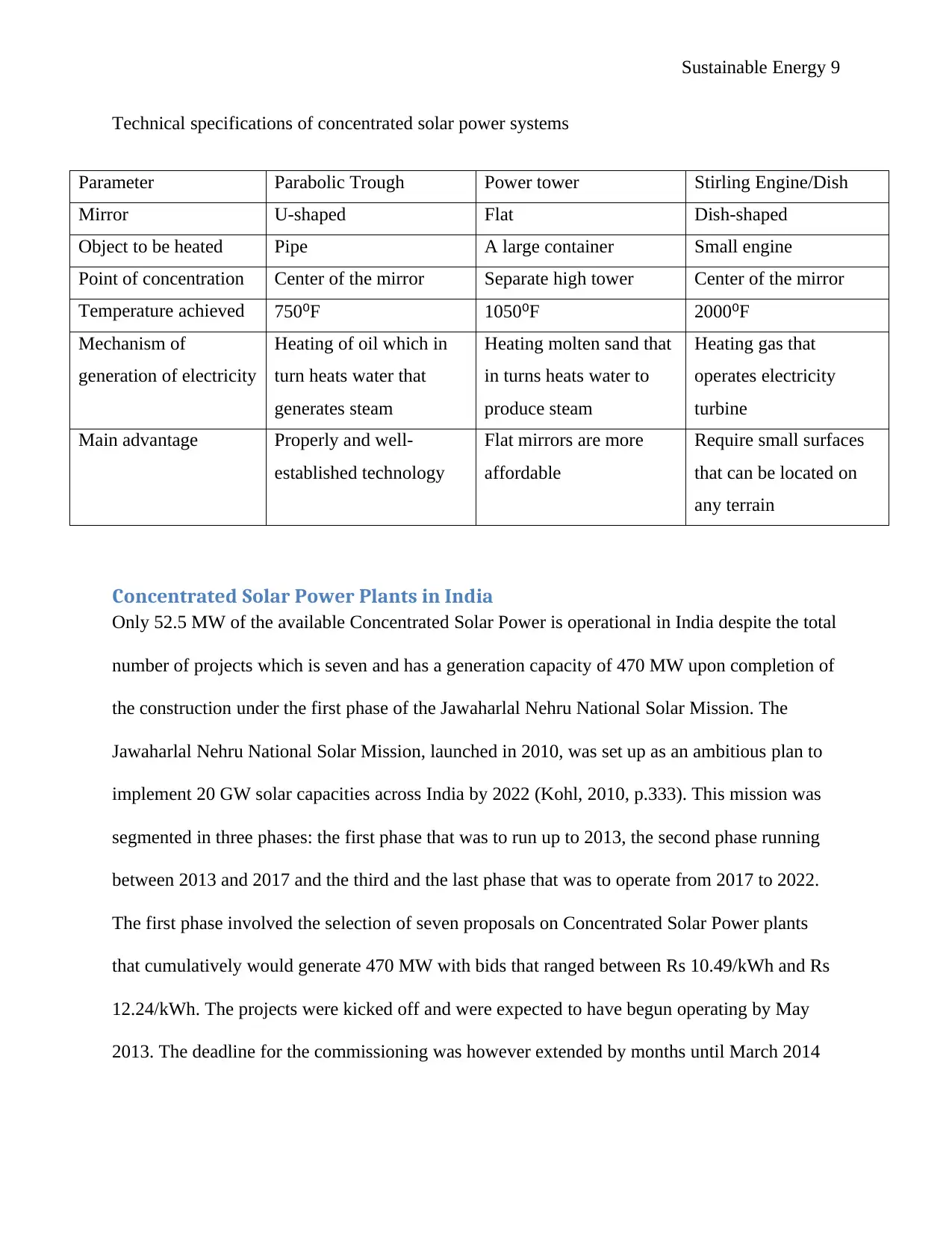
Sustainable Energy 9
Technical specifications of concentrated solar power systems
Parameter Parabolic Trough Power tower Stirling Engine/Dish
Mirror U-shaped Flat Dish-shaped
Object to be heated Pipe A large container Small engine
Point of concentration Center of the mirror Separate high tower Center of the mirror
Temperature achieved 750⁰F 1050⁰F 2000⁰F
Mechanism of
generation of electricity
Heating of oil which in
turn heats water that
generates steam
Heating molten sand that
in turns heats water to
produce steam
Heating gas that
operates electricity
turbine
Main advantage Properly and well-
established technology
Flat mirrors are more
affordable
Require small surfaces
that can be located on
any terrain
Concentrated Solar Power Plants in India
Only 52.5 MW of the available Concentrated Solar Power is operational in India despite the total
number of projects which is seven and has a generation capacity of 470 MW upon completion of
the construction under the first phase of the Jawaharlal Nehru National Solar Mission. The
Jawaharlal Nehru National Solar Mission, launched in 2010, was set up as an ambitious plan to
implement 20 GW solar capacities across India by 2022 (Kohl, 2010, p.333). This mission was
segmented in three phases: the first phase that was to run up to 2013, the second phase running
between 2013 and 2017 and the third and the last phase that was to operate from 2017 to 2022.
The first phase involved the selection of seven proposals on Concentrated Solar Power plants
that cumulatively would generate 470 MW with bids that ranged between Rs 10.49/kWh and Rs
12.24/kWh. The projects were kicked off and were expected to have begun operating by May
2013. The deadline for the commissioning was however extended by months until March 2014
Technical specifications of concentrated solar power systems
Parameter Parabolic Trough Power tower Stirling Engine/Dish
Mirror U-shaped Flat Dish-shaped
Object to be heated Pipe A large container Small engine
Point of concentration Center of the mirror Separate high tower Center of the mirror
Temperature achieved 750⁰F 1050⁰F 2000⁰F
Mechanism of
generation of electricity
Heating of oil which in
turn heats water that
generates steam
Heating molten sand that
in turns heats water to
produce steam
Heating gas that
operates electricity
turbine
Main advantage Properly and well-
established technology
Flat mirrors are more
affordable
Require small surfaces
that can be located on
any terrain
Concentrated Solar Power Plants in India
Only 52.5 MW of the available Concentrated Solar Power is operational in India despite the total
number of projects which is seven and has a generation capacity of 470 MW upon completion of
the construction under the first phase of the Jawaharlal Nehru National Solar Mission. The
Jawaharlal Nehru National Solar Mission, launched in 2010, was set up as an ambitious plan to
implement 20 GW solar capacities across India by 2022 (Kohl, 2010, p.333). This mission was
segmented in three phases: the first phase that was to run up to 2013, the second phase running
between 2013 and 2017 and the third and the last phase that was to operate from 2017 to 2022.
The first phase involved the selection of seven proposals on Concentrated Solar Power plants
that cumulatively would generate 470 MW with bids that ranged between Rs 10.49/kWh and Rs
12.24/kWh. The projects were kicked off and were expected to have begun operating by May
2013. The deadline for the commissioning was however extended by months until March 2014
⊘ This is a preview!⊘
Do you want full access?
Subscribe today to unlock all pages.

Trusted by 1+ million students worldwide
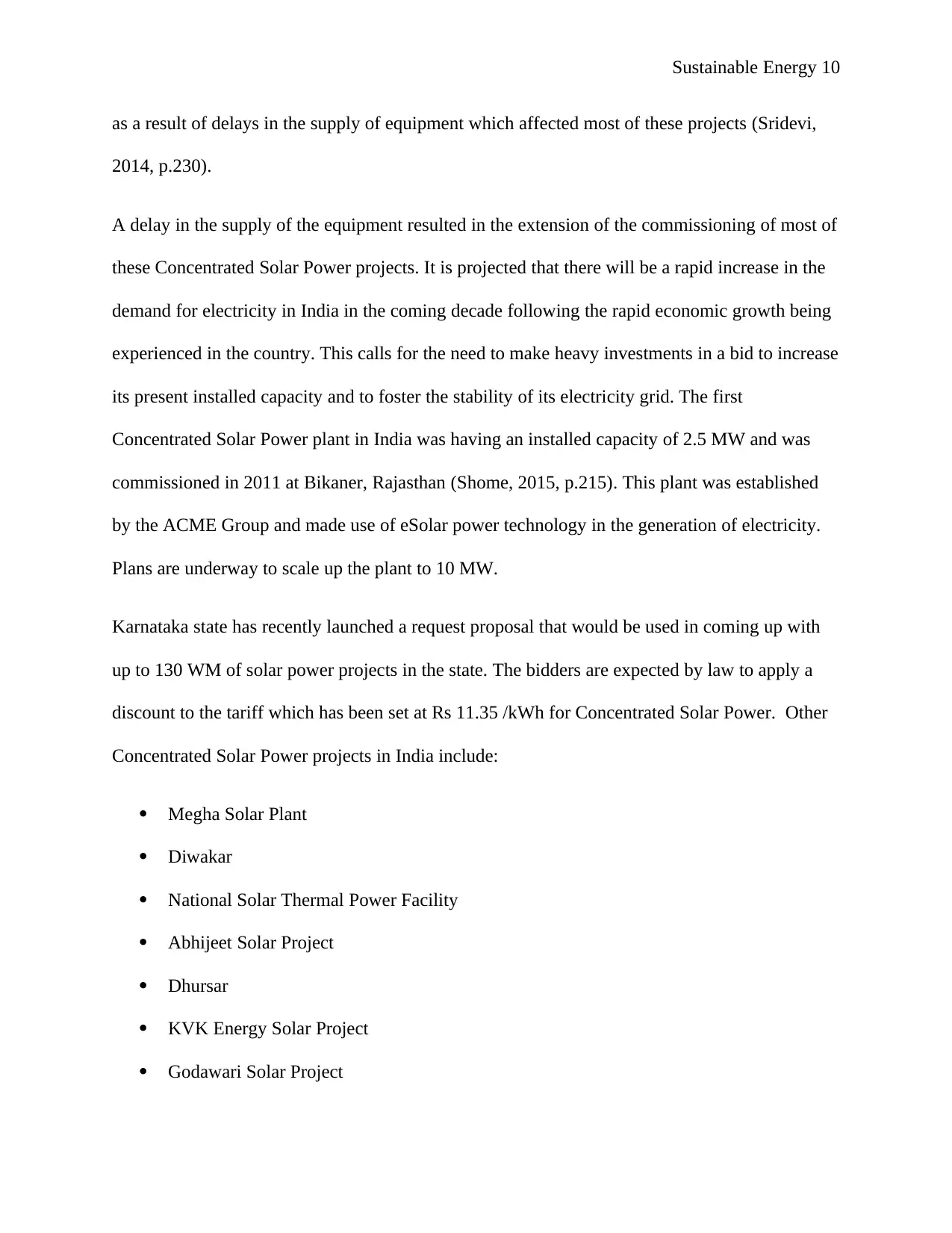
Sustainable Energy 10
as a result of delays in the supply of equipment which affected most of these projects (Sridevi,
2014, p.230).
A delay in the supply of the equipment resulted in the extension of the commissioning of most of
these Concentrated Solar Power projects. It is projected that there will be a rapid increase in the
demand for electricity in India in the coming decade following the rapid economic growth being
experienced in the country. This calls for the need to make heavy investments in a bid to increase
its present installed capacity and to foster the stability of its electricity grid. The first
Concentrated Solar Power plant in India was having an installed capacity of 2.5 MW and was
commissioned in 2011 at Bikaner, Rajasthan (Shome, 2015, p.215). This plant was established
by the ACME Group and made use of eSolar power technology in the generation of electricity.
Plans are underway to scale up the plant to 10 MW.
Karnataka state has recently launched a request proposal that would be used in coming up with
up to 130 WM of solar power projects in the state. The bidders are expected by law to apply a
discount to the tariff which has been set at Rs 11.35 /kWh for Concentrated Solar Power. Other
Concentrated Solar Power projects in India include:
Megha Solar Plant
Diwakar
National Solar Thermal Power Facility
Abhijeet Solar Project
Dhursar
KVK Energy Solar Project
Godawari Solar Project
as a result of delays in the supply of equipment which affected most of these projects (Sridevi,
2014, p.230).
A delay in the supply of the equipment resulted in the extension of the commissioning of most of
these Concentrated Solar Power projects. It is projected that there will be a rapid increase in the
demand for electricity in India in the coming decade following the rapid economic growth being
experienced in the country. This calls for the need to make heavy investments in a bid to increase
its present installed capacity and to foster the stability of its electricity grid. The first
Concentrated Solar Power plant in India was having an installed capacity of 2.5 MW and was
commissioned in 2011 at Bikaner, Rajasthan (Shome, 2015, p.215). This plant was established
by the ACME Group and made use of eSolar power technology in the generation of electricity.
Plans are underway to scale up the plant to 10 MW.
Karnataka state has recently launched a request proposal that would be used in coming up with
up to 130 WM of solar power projects in the state. The bidders are expected by law to apply a
discount to the tariff which has been set at Rs 11.35 /kWh for Concentrated Solar Power. Other
Concentrated Solar Power projects in India include:
Megha Solar Plant
Diwakar
National Solar Thermal Power Facility
Abhijeet Solar Project
Dhursar
KVK Energy Solar Project
Godawari Solar Project
Paraphrase This Document
Need a fresh take? Get an instant paraphrase of this document with our AI Paraphraser
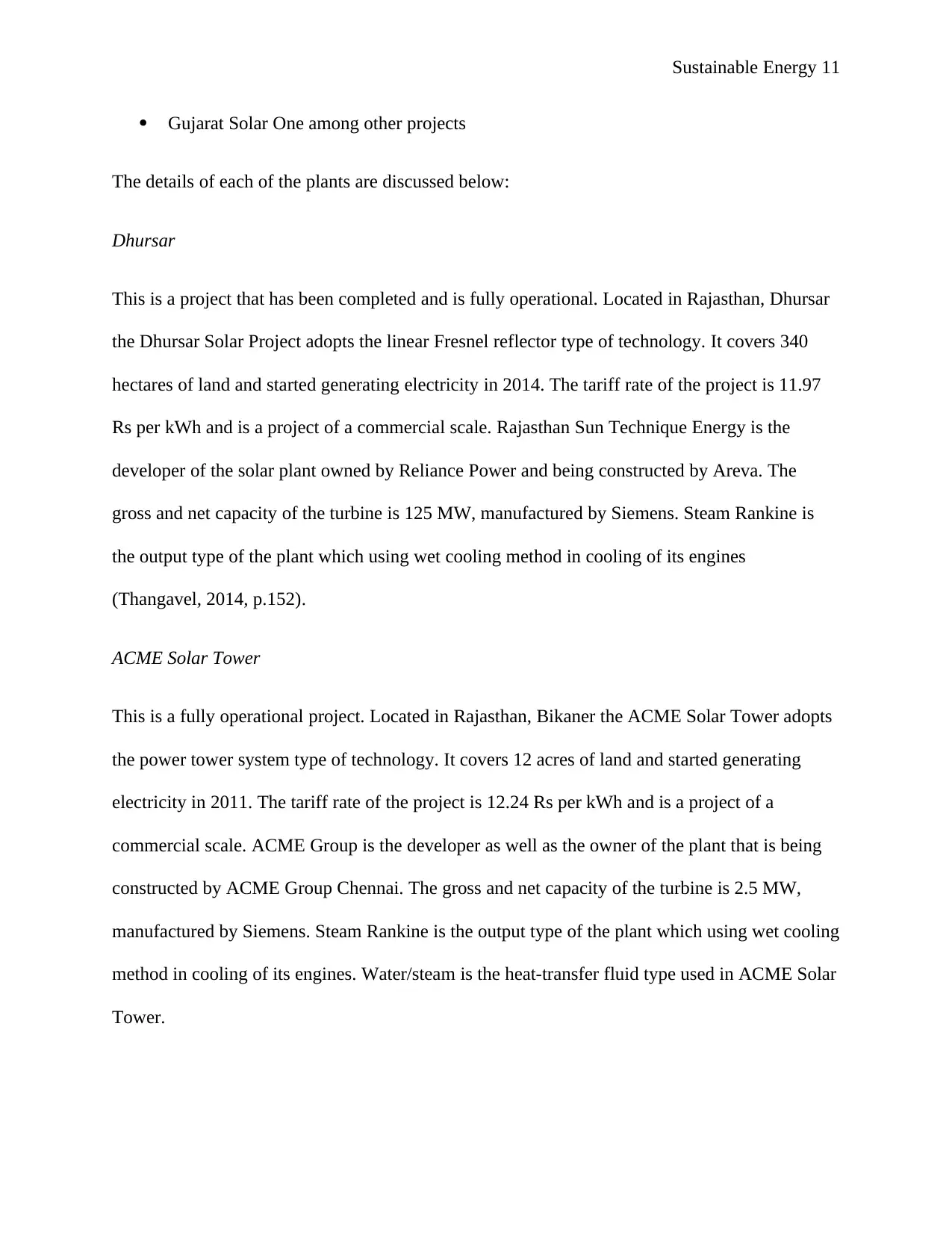
Sustainable Energy 11
Gujarat Solar One among other projects
The details of each of the plants are discussed below:
Dhursar
This is a project that has been completed and is fully operational. Located in Rajasthan, Dhursar
the Dhursar Solar Project adopts the linear Fresnel reflector type of technology. It covers 340
hectares of land and started generating electricity in 2014. The tariff rate of the project is 11.97
Rs per kWh and is a project of a commercial scale. Rajasthan Sun Technique Energy is the
developer of the solar plant owned by Reliance Power and being constructed by Areva. The
gross and net capacity of the turbine is 125 MW, manufactured by Siemens. Steam Rankine is
the output type of the plant which using wet cooling method in cooling of its engines
(Thangavel, 2014, p.152).
ACME Solar Tower
This is a fully operational project. Located in Rajasthan, Bikaner the ACME Solar Tower adopts
the power tower system type of technology. It covers 12 acres of land and started generating
electricity in 2011. The tariff rate of the project is 12.24 Rs per kWh and is a project of a
commercial scale. ACME Group is the developer as well as the owner of the plant that is being
constructed by ACME Group Chennai. The gross and net capacity of the turbine is 2.5 MW,
manufactured by Siemens. Steam Rankine is the output type of the plant which using wet cooling
method in cooling of its engines. Water/steam is the heat-transfer fluid type used in ACME Solar
Tower.
Gujarat Solar One among other projects
The details of each of the plants are discussed below:
Dhursar
This is a project that has been completed and is fully operational. Located in Rajasthan, Dhursar
the Dhursar Solar Project adopts the linear Fresnel reflector type of technology. It covers 340
hectares of land and started generating electricity in 2014. The tariff rate of the project is 11.97
Rs per kWh and is a project of a commercial scale. Rajasthan Sun Technique Energy is the
developer of the solar plant owned by Reliance Power and being constructed by Areva. The
gross and net capacity of the turbine is 125 MW, manufactured by Siemens. Steam Rankine is
the output type of the plant which using wet cooling method in cooling of its engines
(Thangavel, 2014, p.152).
ACME Solar Tower
This is a fully operational project. Located in Rajasthan, Bikaner the ACME Solar Tower adopts
the power tower system type of technology. It covers 12 acres of land and started generating
electricity in 2011. The tariff rate of the project is 12.24 Rs per kWh and is a project of a
commercial scale. ACME Group is the developer as well as the owner of the plant that is being
constructed by ACME Group Chennai. The gross and net capacity of the turbine is 2.5 MW,
manufactured by Siemens. Steam Rankine is the output type of the plant which using wet cooling
method in cooling of its engines. Water/steam is the heat-transfer fluid type used in ACME Solar
Tower.
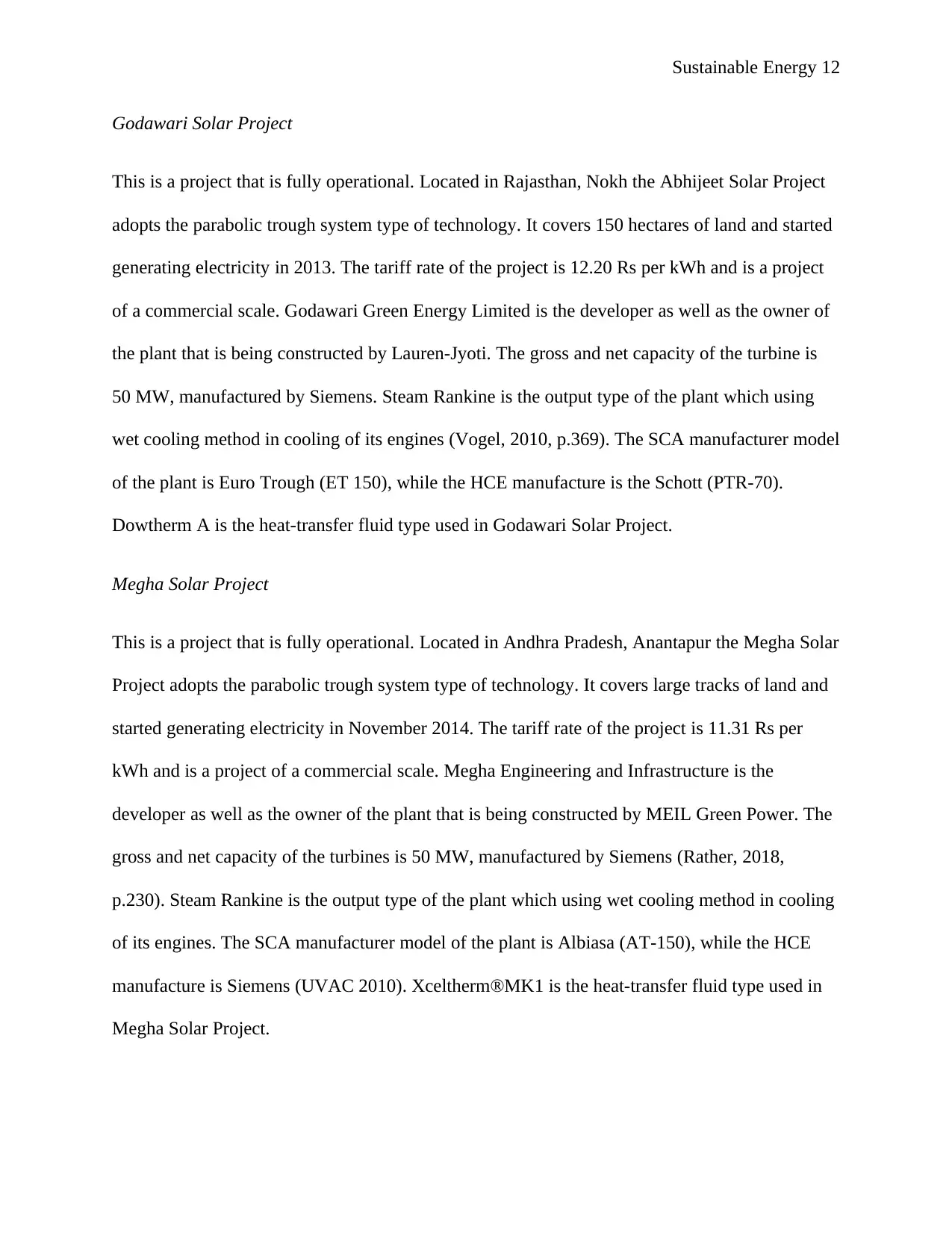
Sustainable Energy 12
Godawari Solar Project
This is a project that is fully operational. Located in Rajasthan, Nokh the Abhijeet Solar Project
adopts the parabolic trough system type of technology. It covers 150 hectares of land and started
generating electricity in 2013. The tariff rate of the project is 12.20 Rs per kWh and is a project
of a commercial scale. Godawari Green Energy Limited is the developer as well as the owner of
the plant that is being constructed by Lauren-Jyoti. The gross and net capacity of the turbine is
50 MW, manufactured by Siemens. Steam Rankine is the output type of the plant which using
wet cooling method in cooling of its engines (Vogel, 2010, p.369). The SCA manufacturer model
of the plant is Euro Trough (ET 150), while the HCE manufacture is the Schott (PTR-70).
Dowtherm A is the heat-transfer fluid type used in Godawari Solar Project.
Megha Solar Project
This is a project that is fully operational. Located in Andhra Pradesh, Anantapur the Megha Solar
Project adopts the parabolic trough system type of technology. It covers large tracks of land and
started generating electricity in November 2014. The tariff rate of the project is 11.31 Rs per
kWh and is a project of a commercial scale. Megha Engineering and Infrastructure is the
developer as well as the owner of the plant that is being constructed by MEIL Green Power. The
gross and net capacity of the turbines is 50 MW, manufactured by Siemens (Rather, 2018,
p.230). Steam Rankine is the output type of the plant which using wet cooling method in cooling
of its engines. The SCA manufacturer model of the plant is Albiasa (AT-150), while the HCE
manufacture is Siemens (UVAC 2010). Xceltherm®MK1 is the heat-transfer fluid type used in
Megha Solar Project.
Godawari Solar Project
This is a project that is fully operational. Located in Rajasthan, Nokh the Abhijeet Solar Project
adopts the parabolic trough system type of technology. It covers 150 hectares of land and started
generating electricity in 2013. The tariff rate of the project is 12.20 Rs per kWh and is a project
of a commercial scale. Godawari Green Energy Limited is the developer as well as the owner of
the plant that is being constructed by Lauren-Jyoti. The gross and net capacity of the turbine is
50 MW, manufactured by Siemens. Steam Rankine is the output type of the plant which using
wet cooling method in cooling of its engines (Vogel, 2010, p.369). The SCA manufacturer model
of the plant is Euro Trough (ET 150), while the HCE manufacture is the Schott (PTR-70).
Dowtherm A is the heat-transfer fluid type used in Godawari Solar Project.
Megha Solar Project
This is a project that is fully operational. Located in Andhra Pradesh, Anantapur the Megha Solar
Project adopts the parabolic trough system type of technology. It covers large tracks of land and
started generating electricity in November 2014. The tariff rate of the project is 11.31 Rs per
kWh and is a project of a commercial scale. Megha Engineering and Infrastructure is the
developer as well as the owner of the plant that is being constructed by MEIL Green Power. The
gross and net capacity of the turbines is 50 MW, manufactured by Siemens (Rather, 2018,
p.230). Steam Rankine is the output type of the plant which using wet cooling method in cooling
of its engines. The SCA manufacturer model of the plant is Albiasa (AT-150), while the HCE
manufacture is Siemens (UVAC 2010). Xceltherm®MK1 is the heat-transfer fluid type used in
Megha Solar Project.
⊘ This is a preview!⊘
Do you want full access?
Subscribe today to unlock all pages.

Trusted by 1+ million students worldwide
1 out of 22
Related Documents
Your All-in-One AI-Powered Toolkit for Academic Success.
+13062052269
info@desklib.com
Available 24*7 on WhatsApp / Email
![[object Object]](/_next/static/media/star-bottom.7253800d.svg)
Unlock your academic potential
Copyright © 2020–2025 A2Z Services. All Rights Reserved. Developed and managed by ZUCOL.




